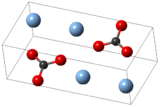Informatics Educational Institutions & Programs
Contents

| |

| |
| Names | |
|---|---|
| IUPAC name
Silver(I) carbonate
| |
| Other names
Argentous carbonate
| |
| Identifiers | |
3D model (JSmol)
|
|
| ChemSpider | |
| ECHA InfoCard | 100.007.811 |
| EC Number |
|
| MeSH | silver+carbonate |
PubChem CID
|
|
| UNII | |
CompTox Dashboard (EPA)
|
|
| |
| |
| Properties | |
| Ag2CO3 | |
| Molar mass | 275.75 g/mol |
| Appearance | Pale yellow crystals |
| Odor | Odorless |
| Density | 6.077 g/cm3[1] |
| Melting point | 218 °C (424 °F; 491 K) decomposes from 120 °C[1][4] |
| 0.031 g/L (15 °C) 0.032 g/L (25 °C) 0.5 g/L (100 °C)[2] | |
Solubility product (Ksp)
|
8.46·10−12[1] |
| Solubility | Insoluble in ethanol, liquid ammonia, acetates, acetone[3] |
| −80.9·10−6 cm3/mol[1] | |
| Structure | |
| Monoclinic, mP12 (295 K) Trigonal, hP36 (β-form, 453 K) Hexagonal, hP18 (α-form, 476 K)[5] | |
| P21/m, No. 11 (295 K) P31c, No. 159 (β-form, 453 K) P62m, No. 189 (α-form, 476 K)[5] | |
| 2/m (295 K) 3m (β-form, 453 K) 6m2 (α-form, 476 K)[5] | |
a = 4.8521(2) Å, b = 9.5489(4) Å, c = 3.2536(1) Å (295 K)[5] α = 90°, β = 91.9713(3)°, γ = 90°
| |
| Thermochemistry | |
Heat capacity (C)
|
112.3 J/mol·K[1] |
Std molar
entropy (S⦵298) |
167.4 J/mol·K[1] |
Std enthalpy of
formation (ΔfH⦵298) |
−505.8 kJ/mol[1] |
Gibbs free energy (ΔfG⦵)
|
−436.8 kJ/mol[1][4] |
| Hazards | |
| Occupational safety and health (OHS/OSH): | |
Inhalation hazards
|
Irritant |
| GHS labelling:[7] | |
 
| |
| Danger | |
| H315, H319, H335 | |
| P261, P305+P351+P338 | |
| NFPA 704 (fire diamond) | |
| Lethal dose or concentration (LD, LC): | |
LD50 (median dose)
|
3.73 g/kg (mice, oral)[6] |
Except where otherwise noted, data are given for materials in their standard state (at 25 °C [77 °F], 100 kPa).
| |
Silver carbonate is the chemical compound with the formula Ag2CO3. This salt is yellow but typical samples are grayish due to the presence of elemental silver. It is poorly soluble in water, like most transition metal carbonates.
Preparation and reactions
Silver carbonate can be prepared by combining aqueous solutions of sodium carbonate with a deficiency of silver nitrate.[8]
Freshly prepared silver carbonate is colourless, but the solid quickly turns yellow.[9]
Silver carbonate reacts with ammonia to give the diamminesilver(I) ([Ag(NH3)2]+) complex ion. Like other diamminesilver(I) solutions, including Tollen's reagent, there is a possibility that explosive Silver nitride may precipitate out of the solution. Silver nitride was previously known as fulminating silver but due to confusions with silver fulminate it has been discontinued by the IUPAC.[10]
With hydrofluoric acid, it gives silver fluoride.
The thermal conversion of silver carbonate to silver metal proceeds via formation of silver oxide:[11]
Uses
The principal use of silver carbonate is for the production of silver powder for use in microelectronics. It is reduced with formaldehyde, producing silver free of alkali metals:[9]
Organic synthesis
Silver carbonate is used as a reagent in organic synthesis.[12] In the Fétizon oxidation, silver carbonate on Celite[13] serves as an oxidising agent to form
- aldehydes from primary alcohols
- ketones from secondary alcohols
- keto-alcohols from diols
- ketones from hydroxymethyl compounds
In the Koenigs-Knorr reaction it is used to convert alkyl bromides to the methyl ethers. It is also employed to convert alkyl bromides into alcohols.[8] As a base, it has been used in the Wittig reaction.[14] and in C-H bond activation.[15]
References
- ^ a b c d e f g h Lide, David R., ed. (2009). CRC Handbook of Chemistry and Physics (90th ed.). Boca Raton, Florida: CRC Press. ISBN 978-1-4200-9084-0.
- ^ Seidell, Atherton; Linke, William F. (1919). Solubilities of Inorganic and Organic Compounds (2nd ed.). New York City: D. Van Nostrand Company. p. 605.
- ^ Comey, Arthur Messinger; Hahn, Dorothy A. (February 1921). A Dictionary of Chemical Solubilities: Inorganic (2nd ed.). New York: The MacMillan Company. p. 203.
- ^ a b Anatolievich, Kiper Ruslan. "silver nitrate". chemister.ru. Retrieved 2014-07-21.
- ^ a b c d Norby, P.; Dinnebier, R.; Fitch, A.N. (2002). "Decomposition of Silver Carbonate; the Crystal Structure of Two High-Temperature Modifications of Ag2CO3". Inorganic Chemistry. 41 (14): 3628–3637. doi:10.1021/ic0111177. PMID 12099865.
- ^ a b "Silver Carbonate MSDS". saltlakemetals.com. Salt Lake City, Utah: Salt Lake Metals. Retrieved 2021-08-05.
- ^ Sigma-Aldrich Co., Silver carbonate. Retrieved on 2021-08-05.
- ^ a b McCloskey C. M.; Coleman, G. H. (1955). "β-d-Glucose-2,3,4,6-Tetraacetate". Organic Syntheses; Collected Volumes, vol. 3, p. 434.
- ^ a b Andreas Brumby et al. "Silver, Silver Compounds, and Silver Alloys" in Ullmann's Encyclopedia of Industrial Chemistry, Wiley-VCH, Weinheim, 2008. doi:10.1002/14356007.a24_107.pub2
- ^ Brumby, Andreas; Braumann, Peter; Zimmermann, Klaus; Brodeck, Francis; Vandevelde, Thierry; Goia, Dan; Renner, Hermann; Schlamp, Gunter; Zimmermann, Klaus; Weise, Wolfgang; Tews, Peter; Dermann, Klaus; Knodler, Alfons; Schroder, Karl-Heinz; Kempf, Bernd; Luschow, Hans; Peter, Cartrin; Schiele, Rainer (2008). Ullmann's Encyclopedia of Industrial Chemistry. p. 49. doi:10.1002/14356007.a24_107.pub2. ISBN 9783527306732. Retrieved 2020-12-24.
- ^ Koga, Nobuyoshi; Shuto Yamada; Tomoyasu Kimura (2013). "Thermal Decomposition of Silver Carbonate: Phenomenology and Physicogeometrical Kinetics". The Journal of Physical Chemistry C. 117: 326–336. doi:10.1021/jp309655s.
- ^ Ladd, Carolyn L. (2001). "Silver(I) Carbonate". Encyclopedia of Reagents for Organic Synthesis. pp. 1–10. doi:10.1002/047084289X.rn01865. ISBN 978-0-470-84289-8.
- ^ Fétizon, Marcel; Li, Yiming; Jiang, Xuefeng (2017). "Silver(I) Carbonate on Celite". Encyclopedia of Reagents for Organic Synthesis. pp. 1–19. doi:10.1002/047084289X.rs014.pub2. ISBN 978-0-470-84289-8.
- ^ Jedinak, Lukas et al. “Use of Silver Carbonate in the Wittig Reaction.” The Journal of Organic Chemistry 78.23 (2013): 12224–12228 https://doi.org/10.1021/jo401972a.
- ^ J. Org. Chem., 2018, 83 (16), pp 9312–9321 https://doi.org/10.1021/acs.joc.8b01284.






















